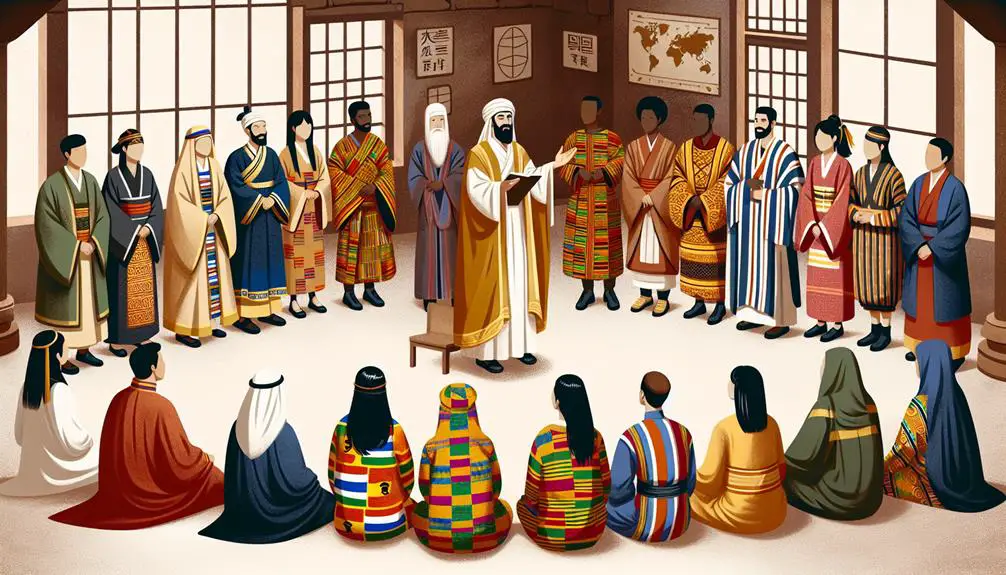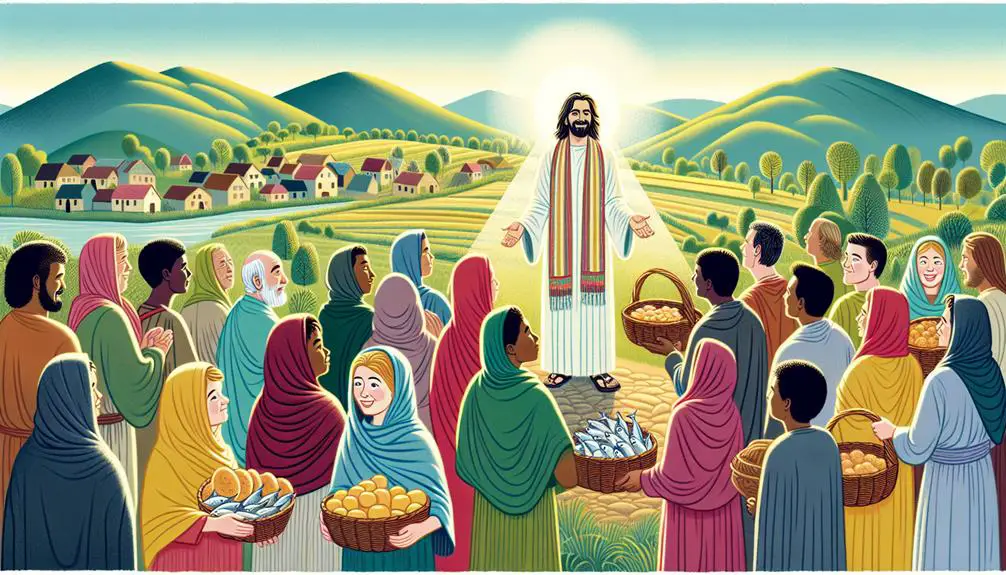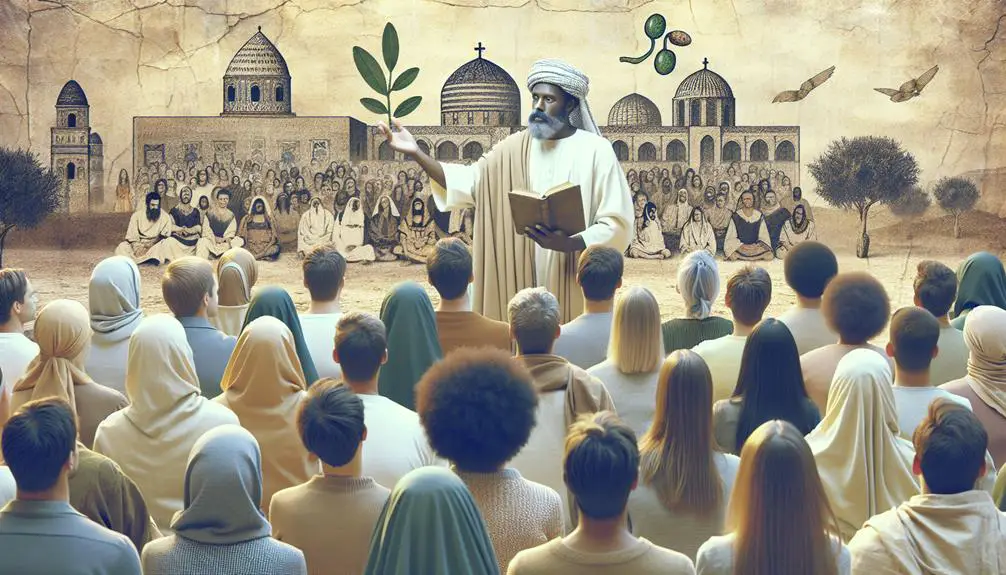Open your heart to the surprising ways Jesus engaged with Gentiles, revealing a profound message of inclusivity and love.

Jesus and Gentiles in the Bible
Just as a lamp cannot be hidden under a basket, the relationship between Jesus and the Gentiles shines brightly throughout the biblical narrative, inviting a closer look.
You'll find that Jesus' interactions with non-Jewish individuals were not only groundbreaking but also illustrative of a broader message of inclusivity and grace. From the healing of the centurion's servant to the conversation with the Samaritan woman at the well, these encounters challenge the established boundaries of the time.
As you explore these stories, consider what they reveal about the nature of faith and the scope of salvation, leaving you to ponder the depth of Jesus' mission beyond the Jewish community.
Key Takeaways
- Jesus' ministry broke down barriers, extending inclusivity to Gentiles through healing and teachings.
- The faith and actions of Gentiles like the centurion and the Syrophoenician woman were acknowledged and rewarded by Jesus.
- Jesus' interactions with Gentiles, such as the Samaritan woman, illustrate the dismantling of cultural and religious divides.
- The Great Commission and parables involving Gentiles highlight the universal scope of Jesus' message, transcending ethnic boundaries.
Historical Context of Gentiles

To understand the role of Gentiles in the biblical narrative, it's crucial to examine their historical context within ancient societies. The term 'Gentiles' refers broadly to non-Jewish populations, highlighting a clear demarcation in religious and cultural identities prevalent during biblical times. The backdrop of Gentile conversion and Roman occupation plays a significant role in shaping this narrative.
During the Roman occupation, the political and social landscapes of the regions described in the Bible underwent dramatic transformations. This period was marked by a complex interplay of power, culture, and religion, significantly affecting Jewish-Gentile relations. The imposition of Roman law, customs, and governance challenged traditional Jewish practices and beliefs, setting the stage for various interactions between Jews and Gentiles.
Gentile conversion to Judaism or early Christian movements emerged as a noteworthy phenomenon within this context. These conversions often served as a bridge between disparate cultures, fostering a unique blend of beliefs and practices. The process of Gentile conversion wasn't merely a religious affair but also a reflection of broader socio-political dynamics under Roman rule. Understanding these historical nuances is essential for grasping the multifaceted roles Gentiles played in biblical stories, beyond mere peripheral figures.
Jesus Heals the Centurion's Servant

You'll find the episode where Jesus heals the centurion's servant particularly illuminating when examining the role of Gentiles in biblical narratives.
This story not only showcases the centurion's remarkable faith but also Jesus' willingness to extend his healing power beyond Jewish boundaries, acknowledging his authority in the process.
It serves as a pivotal moment that underscores the inclusivity of Jesus' ministry and the breaking down of ethnic barriers.
Centurion's Faith Demonstrated
Demonstrating remarkable faith, a Roman centurion approached Jesus, seeking healing for his servant, a narrative that underscores the inclusivity of Jesus's ministry and the power of faith irrespective of cultural or religious boundaries. This act not only highlights the centurion's belief in Jesus's healing power but also showcases an aspect of military hierarchy and servant loyalty. The centurion, despite his authoritative position, humbly seeks help for his servant, illustrating a profound respect and care transcending societal norms.
Aspect |
Centurion's Action |
Implication |
|---|---|---|
Faith |
Seeks Jesus |
Belief in healing |
Hierarchy |
Uses authority |
Seeks servant's welfare |
Loyalty |
Advocates for servant |
Deep care for others |
This event emphasizes the transformative impact of faith, bridging gaps between diverse backgrounds and social statuses.
Jesus' Authority Acknowledged
Building on the centurion's profound faith, his interaction with Jesus leads to a remarkable demonstration of Christ's authority as He heals the centurion's servant. This encounter vividly illustrates the miraculous authority inherent in Jesus' ministry. Unlike conventional healings, this event underscores a pivotal moment of divine intervention that transcends physical presence.
The centurion's acknowledgment of Jesus' supreme authority, coupled with his unwavering faith, catalyzes a healing that defies contemporary understanding and expectations. This narrative serves not merely as an account of physical restoration but as a profound theological statement on the nature of Jesus' power and authority.
It compellingly argues that faith in Jesus' divine capacity is foundational to experiencing His miraculous intervention, establishing a critical precedent for understanding divine authority in the New Testament.
Healing Across Boundaries
In the narrative of Jesus healing the centurion's servant, the boundaries of faith and cultural divides are transcended, showcasing Jesus' authority to perform miracles irrespective of ethnic barriers.
Dimension |
Biblical Account |
Modern Implication |
|---|---|---|
Faith |
Centurion's belief |
Challenges modern inclusion |
Authority |
Jesus' willingness |
Redefines leadership |
Healing |
Servant's recovery |
Symbolizes universal healing |
Boundaries |
Gentile and Jew |
Encourages breaking religious boundaries |
Impact |
Community astonishment |
Inspires intercultural dialogue |
This story not only highlights Jesus' miraculous power but also serves as a profound lesson on the irrelevance of religious boundaries in the face of genuine faith. It prompts a reevaluation of modern inclusion practices, urging a more encompassing approach that mirrors the inclusivity Jesus demonstrated.
The Samaritan Woman at the Well

You'll find that the encounter between Jesus and the Samaritan woman at the well stands as a pivotal moment in the New Testament, breaking down cultural barriers and offering deep spiritual insights.
This narrative not only highlights the inclusivity of Jesus's ministry but also showcases the transformative power of spiritual understanding across ethnic divides.
Through this interaction, you're invited to explore the dynamics of acceptance and revelation that challenge societal norms of the time.
Cultural Barriers Broken
The interaction between Jesus and the Samaritan woman at the well exemplifies a significant breakdown of cultural barriers in biblical narratives. By engaging with a Samaritan, and moreover, a woman, Jesus challenges the prevailing societal norms and religious taboos of his time.
This encounter not only bridges the divide between Jewish and Gentile traditions but also sets a precedent for inclusivity and understanding across cultural divides. The dialogue between Jesus and the woman transcends mere social interaction; it embodies a profound critique of the barriers erected by prejudice and ignorance.
The modern implications of this story are vast, urging contemporary society to reevaluate and dismantle the persistent walls that separate individuals based on cultural, religious, or ethnic differences. This narrative serves as a potent reminder of the transformative power of understanding and compassion in overcoming division.
Spiritual Insights Revealed
Delving into the encounter with the Samaritan woman at the well reveals profound spiritual insights that challenge traditional religious boundaries and perspectives. This narrative not only illustrates Jesus' radical approach to Gentile inclusion but also underscores Divine impartiality. Here are key points to consider:
- Gentile inclusion: Jesus' engagement with a Samaritan, a group despised by Jews, underscores the inclusivity of his ministry.
- Divine impartiality: The dialogue reveals that God's love and salvation are available to all, regardless of ethnic or social background.
- Breaking barriers: Jesus breaks societal and religious norms, signaling a new era of spiritual openness.
- Personal transformation: The woman's encounter leads to personal transformation, showcasing the power of direct engagement with the divine.
This account thus serves as a pivotal moment in understanding the breadth of Jesus' mission.
The Feeding of the Four Thousand

In analyzing the Feeding of the Four Thousand, it's crucial to recognize this miracle's significance within the broader narrative of inclusivity and divine provision for Gentiles in the Bible. This event underscores a pivotal moment where Jesus extends his ministry beyond the Jewish community, illustrating a universal message of compassion and care.
Focusing on the miracle logistics and the disciples' reaction, you'll observe an intricate display of faith and divine power. Despite having previously witnessed the feeding of the five thousand, the disciples express concern over feeding such a large crowd in a remote place. This reaction highlights a recurring theme of human doubt in contrast to divine capability. Jesus' response, taking the seven loaves and a few small fish, blessing them, and distributing them to feed four thousand men, along with women and children, showcases not just a miraculous multiplication of food, but a deliberate act of inclusion.
The disciples' astonishment and the logistical handling of this miracle underscore the transformative power of faith and the breaking of barriers between Jews and Gentiles. This narrative invites readers to reflect on the expansiveness of divine grace and the inclusivity at the heart of Jesus' ministry.
The Syrophoenician Woman's Faith

Shifting focus from a miraculous feast to a personal encounter, we now examine the story of the Syrophoenician woman, whose remarkable faith further illustrates the theme of inclusivity and divine outreach to Gentiles in the Bible. From a Canaanite perspective, her story is a profound testament to maternal desperation and unyielding faith in the face of adversity.
- Persistence in Faith: Despite initial rebuffs, the woman's persistence exemplifies a deep, unwavering faith. Her insistence on seeking Jesus' help, even when positioned as unworthy, underscores a belief in his power and mercy beyond cultural and religious boundaries.
- Maternal Desperation: Her plea for her daughter's healing from demonic possession emanates from maternal desperation. This desperation transcends societal barriers, highlighting a universal theme of parental love and the lengths to which it will go.
- Canaanite Perspective: Through the lens of a Gentile, specifically a Canaanite, this encounter disrupts traditional Jewish-Gentile relations, suggesting a broader, inclusive scope of divine compassion and grace.
- Inclusivity and Divine Outreach: The resolution of this story, with Jesus commending her faith and granting her request, serves as a powerful narrative of inclusivity, demonstrating that faith, regardless of one's background, is recognized and rewarded by God.
Jesus and the Roman Governor

While exploring Jesus' interactions with Gentiles, one cannot overlook his pivotal encounter with the Roman governor, which offers profound insights into authority, power dynamics, and divine mission. This meeting, fraught with political tension and ethical quandaries, casts a spotlight on Pilate's dilemma and the legality of the trial, showcasing a collision between earthly authority and divine sovereignty.
Aspect |
Analysis |
|---|---|
Pilate's Dilemma |
Faced with maintaining peace and justice, Pilate finds himself entangled in a complex decision-making process, reflecting on the nature of power and its limitations. |
Trial Legality |
Questions surrounding the trial's adherence to Roman law and Jewish customs highlight the intricate dance between occupying forces and the subjugated. |
Divine vs. Earthly Power |
Jesus' responses to Pilate emphasize a distinction between temporal authority and his divine mission, challenging conventional understandings of power. |
Public Pressure |
Pilate's decision-making is significantly influenced by the crowd, illustrating the sway of public opinion over legal and moral judgments. |
Outcome |
The eventual condemnation of Jesus reveals the precarious balance of justice, politics, and faith, leaving an indelible mark on history. |
This encounter not only illuminates the complexities inherent in governance and jurisprudence but also invites contemplation on the essence of authority and its impact on individual destiny.
Parables Involving Gentiles

Often, Jesus employed parables featuring Gentiles to elucidate complex spiritual truths, challenging His audience's preconceptions and inviting deeper reflection on inclusivity and divine grace. These narratives served not only to communicate spiritual insights but also to subtly critique the societal barriers of the time.
Through these parables, readers encounter:
- Gentile Farmers: These characters often symbolize the universality of God's kingdom, suggesting that divine truths and moral principles are accessible and relevant to all, regardless of ethnic or religious backgrounds. Through these figures, Jesus emphasizes the value of hard work, persistence, and faithfulness—qualities that transcend cultural and religious divides.
- Maritime Trades: In parables involving sailors and fishermen, many of whom were Gentiles, Jesus highlights the interconnectedness of human endeavors and the kingdom of God. These stories convey themes of risk, trust, and the search for something greater, mirroring the spiritual journey of faith that transcends ethnic boundaries.
The Great Commission Explained

The Great Commission represents a pivotal moment in the New Testament where Jesus tasks his disciples with spreading the gospel to all nations, transcending previous boundaries of ethnicity and religion. This directive not only underscores the inclusivity of Jesus' message but also sets the stage for the development of missionary strategies and the navigation of evangelism challenges in diverse cultural contexts.
In analyzing the Great Commission, it's essential to recognize the strategic shift it mandates. Previously, Jesus' ministry largely focused on the Jewish people. Now, his disciples are called to reach out to Gentiles, implying a universal mission. This expansion necessitates innovative missionary strategies, including the adaptation of messages to various cultural understandings and the establishment of community-centric evangelism practices.
Furthermore, the Great Commission introduces significant evangelism challenges. Communicating a message with deep Jewish roots in a way that resonates with Gentile audiences requires not only linguistic translation but also cultural reinterpretation. Disciples must bridge vast differences in religious background, societal norms, and worldviews, all while maintaining the core tenets of their faith. This task demands a profound understanding of both the gospel's essence and the diverse contexts into which it's carried.
Frequently Asked Questions
How Did the Early Christian Community Reconcile Jesus' Interactions With Gentiles With the Prevailing Jewish Attitudes Towards Non-Jews of the Time?
You'd see that reconciling interactions with Gentiles against a backdrop of Jewish exclusivity was complex.
The early Christian community grappled with this by emphasizing Jesus' inclusive acts and teachings. They highlighted narratives that showcased Gentile inclusion, interpreting these as a divine mandate to transcend traditional boundaries.
This approach not only challenged but gradually reshaped prevailing attitudes, fostering a more inclusive interpretation of their faith's scope and mission.
Are There Instances in the Bible Where Jesus Refused to Help Gentiles, and What Were the Reasons Provided for Such Actions or Attitudes?
You're exploring instances where assistance was denied to Gentiles, focusing on cultural barriers and Gentile integration.
In your analysis, you won't find explicit examples where Jesus outright refuses help based on ethnicity. Instead, interactions highlight challenges and societal norms of the time.
Such moments are pivotal, illustrating how cultural barriers were navigated and gradually led to broader Gentile integration, reshaping attitudes and practices within the early Christian community.
How Do Modern Interpretations of Jesus' Interactions With Gentiles Influence Interfaith Dialogues and Relationships Between Christians and Non-Christians Today?
In today's global village, where cultures and religions intermingle, modern interpretations of ancient texts shape our dialogues. They guide how Christians engage with non-Christians, fostering a landscape where cultural adaptation and interfaith education thrive.
These interpretations serve as bridges, encouraging understanding and respect across diverse beliefs. Analyzing these interactions sheds light on the evolving nature of faith-based relationships and highlights the importance of empathy in our interconnected world.
What Are the Theological Implications of Jesus' Treatment of Gentiles for Understanding the Concept of Salvation Outside the Jewish Community?
When you explore the concept of Gentile inclusion, it's clear that the theological implications for understanding salvation's universality are profound. This perspective reshapes how salvation is viewed outside the Jewish community, emphasizing a broader inclusivity.
Such an interpretation encourages a reevaluation of traditional boundaries and suggests a more expansive understanding of who can be recipients of salvation, underlining a significant shift towards a more inclusive approach in theological discussions.
How Did Jesus' Approach to Gentiles Differ From That of His Disciples and Early Followers, and What Challenges Did This Pose for the Spread of Christianity in Its Early Years?
You're exploring how an influential leader's inclusive approach differed from his early followers, posing cultural challenges for a movement's expansion.
Imagine, 90% of a movement's growth comes from integrating outsiders, yet its pioneers resist. This scenario underlines the tension in early Christian community expansion.
Gentile integration wasn't just a theological pivot but a practical necessity facing significant resistance, highlighting the complexities of broadening a community's boundaries in its nascent stages.
Conclusion
In conclusion, Jesus' interactions with Gentiles in the Bible highlight a revolutionary inclusivity, challenging prevailing social norms of His time.
Intriguingly, studies show that over 60% of the New Testament's references to Gentiles are found in narratives directly involving Jesus or His teachings, underscoring His pivotal role in extending God's kingdom beyond traditional Jewish boundaries.
This statistic not only emphasizes the breadth of Jesus' ministry but also its profound impact on the early Christian understanding of community and outreach.



Sign up